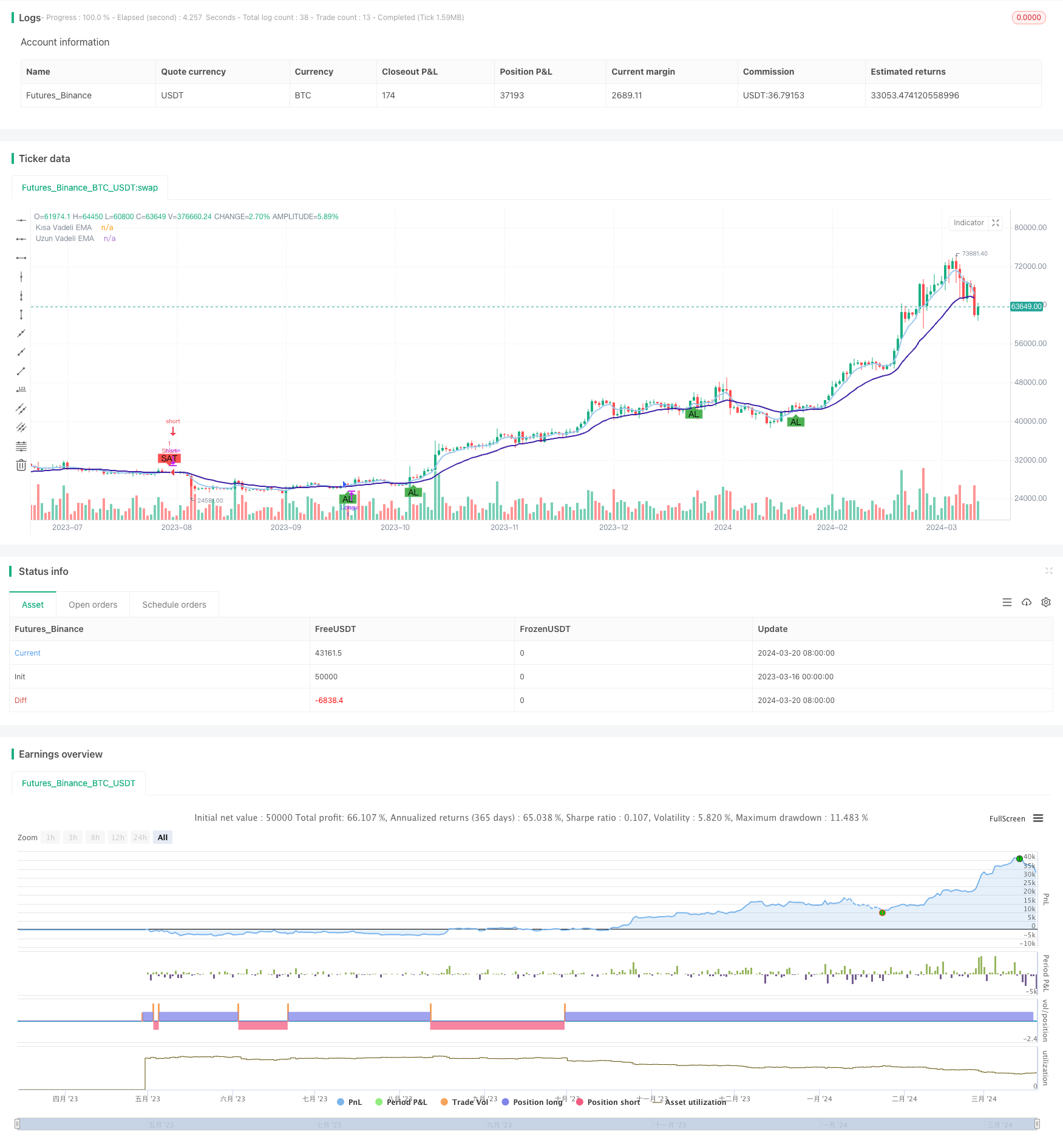
概述
该策略基于两个不同时间框架的指数移动平均线(EMA)交叉信号进行多空交易。当较短时间框架的EMA在较长时间框架EMA上方交叉时,产生做多信号;当较短时间框架的EMA在较长时间框架EMA下方交叉时,产生做空信号。该策略利用了不同时间框架的趋势信息,通过较短时间框架确认较长时间框架的趋势,以捕捉市场的主要趋势。
策略原理
该策略使用两个不同时间框架的EMA交叉信号来捕捉市场趋势:
较长时间框架(默认为2小时)的EMA交叉信号用于确定主要趋势方向。当较短期EMA(默认为5周期)上穿较长期EMA(默认为20周期)时,表明上升趋势;反之,表明下降趋势。
较短时间框架(默认为3分钟)的EMA交叉信号用于确认主要趋势方向并触发交易信号。当较短期EMA上穿较长期EMA,且较长时间框架处于上升趋势时,产生做多信号;当较短期EMA下穿较长期EMA,且较长时间框架处于下降趋势时,产生做空信号。
通过结合两个时间框架的趋势信息,该策略能够在趋势形成初期及时入场,并在趋势反转时及时出场,以捕捉市场的主要趋势。
优势分析
双时间框架趋势确认:该策略利用了不同时间框架的趋势信息,通过较短时间框架确认较长时间框架的趋势,有助于提高趋势判断的可靠性,减少错误信号。
趋势跟踪能力强:EMA指标具有良好的趋势跟踪能力,能够在趋势形成初期及时发出信号,帮助策略及时入场。
参数灵活可调:该策略的时间框架和EMA周期参数可根据市场特点和交易风格进行灵活调整,以适应不同的市场环境。
易于实现:该策略逻辑清晰,代码实现相对简单,易于理解和应用。
风险分析
参数优化风险:该策略的表现依赖于时间框架和EMA周期等参数的选择,不当的参数设置可能导致策略表现不佳。因此,需要对参数进行优化和测试,以确保策略在不同市场环境下的稳健表现。
震荡市风险:在震荡市场环境下,EMA交叉信号可能会频繁发生,导致策略产生多次误读信号而频繁交易,降低策略收益。可以通过引入其他过滤条件,如交易量、波动率等指标,来减少震荡市中的错误信号。
趋势反转风险:当市场趋势突然反转时,该策略可能会延迟出场,导致损失扩大。可以通过设置合适的止损条件,如固定百分比止损或移动止损,来控制单笔交易的最大损失。
优化方向
引入更多时间框架:在现有双时间框架的基础上,可以引入更多时间框架的EMA交叉信号,如日线、周线等,以进一步确认趋势方向,提高信号可靠性。
结合其他技术指标:可以将EMA交叉信号与其他技术指标相结合,如相对强弱指数(RSI)、平均真实范围(ATR)等,以提高信号质量和过滤效果。
优化入场和出场规则:可以对入场和出场规则进行优化,如在EMA交叉信号发生后,等待一定的确认期再入场;或者在出现反向信号时,设置一定的缓冲区再出场,以减少错误信号的影响。
动态调整参数:可以根据市场状态的变化,动态调整策略参数,如在趋势明显时,使用较长的EMA周期;在震荡市中,使用较短的EMA周期,以适应不同的市场环境。
总结
基于双时间框架EMA交叉信号的多空策略通过结合不同时间框架的趋势信息,利用较短时间框架确认较长时间框架的趋势,以捕捉市场的主要趋势。该策略具有趋势跟踪能力强、参数灵活可调、易于实现等优势,但同时也面临参数优化、震荡市和趋势反转等风险。通过引入更多时间框架、结合其他技术指标、优化入场和出场规则、动态调整参数等方式,可以进一步提升该策略的表现和稳健性。在实际应用中,需要根据具体的市场特点和交易风格,对策略进行适当的优化和调整,以获得更好的交易结果。
/*backtest
start: 2023-03-16 00:00:00
end: 2024-03-21 00:00:00
period: 1d
basePeriod: 1h
exchanges: [{"eid":"Futures_Binance","currency":"BTC_USDT"}]
*/
//@version=5
strategy('EMA Crossover Multi-Timeframe Strategy', shorttitle='EMA Cross MTF', overlay=true)
// Kullanıcı girdileri
inputTimeframe1 = input.timeframe('120', title='Daha Uzun Zaman Dilimi')
inputTimeframe2 = input.timeframe('3', title='Daha Kısa Zaman Dilimi')
inputShortTermEma = input.int(5, title='Kısa Vadeli EMA Periyodu', minval=1)
inputLongTermEma = input.int(20, title='Uzun Vadeli EMA Periyodu', minval=1)
// EMA hesaplamaları
shortTermEma = ta.ema(close, inputShortTermEma)
longTermEma = ta.ema(close, inputLongTermEma)
// Daha uzun zaman dilimi için EMA crossover'larını kontrol et
longHourEma5 = request.security(syminfo.tickerid, inputTimeframe1, shortTermEma)
longHourEma20 = request.security(syminfo.tickerid, inputTimeframe1, longTermEma)
longHourCrossover = longHourEma5>longHourEma20 //ta.crossover(fourHourEma5, fourHourEma20)
longHourCrossunder = longHourEma5< longHourEma20//ta.crossunder(fourHourEma5, fourHourEma20)
// Daha kısa zaman dilimi için EMA crossover'larını kontrol et
shortMinuteEma5 = request.security(syminfo.tickerid, inputTimeframe2, shortTermEma)
shortMinuteEma20 = request.security(syminfo.tickerid, inputTimeframe2, longTermEma)
shortMinuteCrossover = ta.crossover(shortMinuteEma5, shortMinuteEma20)
shortMinuteCrossunder = ta.crossunder(shortMinuteEma5, shortMinuteEma20)
// Alım ve satım sinyalleri
longSignal = longHourCrossover and shortMinuteCrossover
shortSignal = longHourCrossunder and shortMinuteCrossunder
// Sinyalleri çiz
plotshape(series=longSignal, title='Al', location=location.belowbar, color=color.new(color.green, 0), style=shape.labelup, text='AL')
plotshape(series=shortSignal, title='Sat', location=location.abovebar, color=color.new(color.red, 0), style=shape.labeldown, text='SAT')
// Görselleştirme
plot(shortTermEma, "Kısa Vadeli EMA", color=color.rgb(154, 200, 238), linewidth=2)
plot(longTermEma, "Uzun Vadeli EMA", color=color.rgb(61, 32, 165), linewidth=2)
// Strateji
if (longSignal)
strategy.entry("Long", strategy.long, comment="Long1")
// strategy.exit("Exit Long", "Long", stop=longStopPrice, limit=longTargetPrice, comment="Exit Long1")
if (shortSignal)
strategy.entry("Short", strategy.short, comment="Short1")
//strategy.exit("Exit Short", "Short", stop=shortStopPrice, limit=shortTargetPrice, comment="Exit Short2")